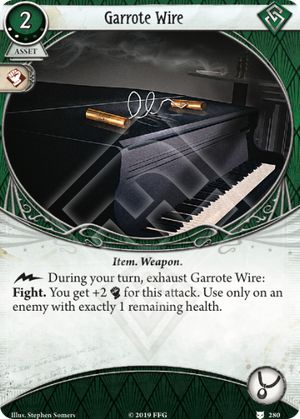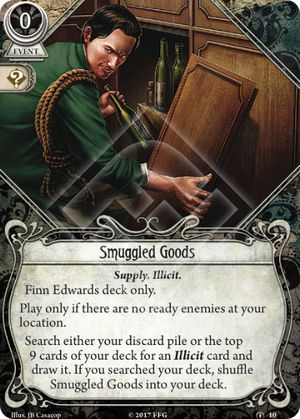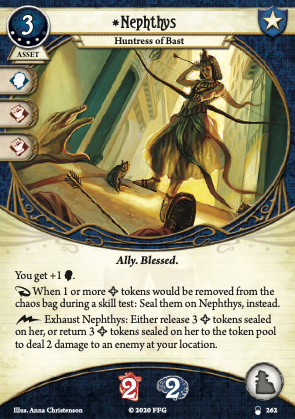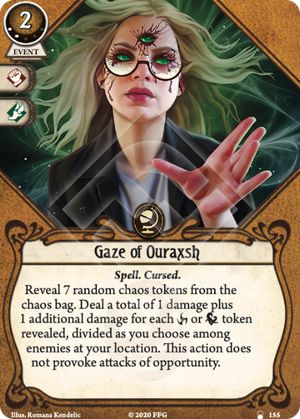
Oh I get it! It takes up an accessory slot because it goes around the neck. I see what you did there FFG. Need 200 characters I'll just talk about my day until there. Started off sleepy but got coffee

Oh I get it! It takes up an accessory slot because it goes around the neck. I see what you did there FFG. Need 200 characters I'll just talk about my day until there. Started off sleepy but got coffee

This is an insane card. Tutor for 0 resource is obviously. Comes along well with Finn's other signature Finn's Trusty .38, which will often be your first target. Very soon, you are likely to search your deck for Lockpicks, maybe other/heavier weapons.
I really like to put it back in deck, delay your weakness(es), get a chance to use it again. Very versatile card, it can be used as a tutor, refill for weapons or Lockpicks, shuffle if you know that your weakness is on top, and even you had 0 Illicit card in your deck, still a ? Symbol -which will almost never happen cause of Finn's Trusty .38.
I like to play a heavy-drawer Finn and the ability to put this back in the deck is a good way to avoid reshuffling it. Helps me to: -Avoid the horror, sometimes a critical issue for Finn. -Bury my weaknesses. -Keep my discard pile for Scavenging By the way Caught Red-Handed can most of the time achieve the same purpose.
According to the wording, I guess that you can search your deck, even if you don't have an Illicit card in it and then put back Smuggled Goods in it. Can you though, search an empty deck ?

Dealing 2 damage (to an elite or foe engaged with ally) as a free action is very powerful!
I'm looking at this as a fun new ally for Leo Anderson to build around! Earlier Leo got Priest of Two Faiths to add free tokens. With [Tempt Fate] you can add a lot of tokens quickly.
Confused on this wording: "Either release 3 tokens sealed on her, or return 3 tokens sealed on her to the token pool..."
Unclear why someone would not always want them to release them back into the chaos bag. This cycles the tokens so you can seal them back on her later.

Great item overall, but notably lacks the ability to finish off a foe you've spent your turn weakening. After looking through the windows for fast actions there's one before each of your actions during your turn, assuming I'm reading it right, but there isn't a window AFTER your last action.
Since the Garrote Wire can only be used during your turn, if you spend your entire turn chasing down a monster and manage to bring it down to one life, you can awkwardly have your turn end with a piano wire all ready to use and a nightgaunt all ready to be choked out without the opportunity to ever use it.
It still gets plenty of mileage for sure, but due to timing it has felt pretty awkward to use sometimes.

I had 6 curses (no bless) in the bag today and I needed to do 2 damage to a dumb Witch. Pulled 0 curses, did 1 damage.
3/10 the lasting personal trauma outweighs the general favorability of this card.